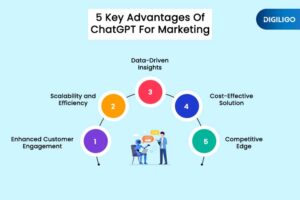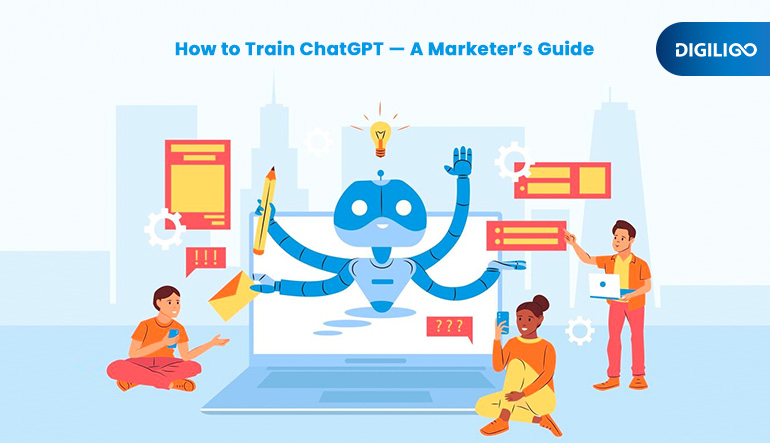The digital world has brought AI technologies into the marketing arena. ChatGPT is one of the latest marketing tools that is completely transforming the way marketers talk to their customers. The cutting-edge process of ChatGPT enables enterprises to automate content creation, customer service, and engagement at scale, making it an indispensable tool.
With its built-in language processing technology, ChatGPT provides an opportunity for creating content tailored to the specific needs of the audience, automating customer service and improving the user experience across multiple platforms.
However, marketers should bear in mind that ChatGPT is not an out-of-the-box tool and requires ChatGPT training to configure and customise it to meet their particular needs.
While it is possible since ChatGPT’s potential can be exploited, being able to train it to meet particular marketing needs is the key factor. This guide will guide you on “How to Train ChatGPT” so that it becomes a vital component of your marketing efforts.
Before Knowing ChatGPT Training, Let’s Understand The Basics of ChatGPT For Marketing
The GPT (Generative Pre-trained Transformer) model is the underlying concept of ChatGPT, and it is trained to comprehend the text and produce human-like text as an output. This AI has been trained on a large specific text from the internet, which in turn helps it to generate answers to queries, have conversations as humans do, and produce content that closely resembles human writing.
For marketers, it means having a virtual assistant who can draft emails, write blogs, compose for social media platforms, and even interact with customers in real time.
Training ChatGPT beyond its pre-trained knowledge includes not only what the ChatGPT has learned but also how the system has learned it. It implies the model fitting to recognise and address the particular language, tune and mission of your marketing campaigns.
The training process guarantees that ChatGPT will be able to represent your brand’s tone accurately, answer questions that are input-specific, and create content that is of relevance to your audience.
A grasp of these basics is the key to a successful implementation of ChatGPT before knowing “How to Train ChatGPT” for your marketing purposes.
5 Key Advantages Of ChatGPT For Marketing


Enhanced Customer Engagement:
With ChatGPT, businesses can offer personalised interactions around the clock. By integrating this AI technology into chatbots, companies can engage with customers in real-time, addressing queries promptly and fostering a deeper connection.
Scalability and Efficiency:
ChatGPT enables automated responses, allowing businesses to handle multiple customer inquiries simultaneously. This scalability enhances efficiency by reducing response times and streamlining communication processes, thus boosting overall productivity.
Data-Driven Insights:
Utilising ChatGPT for marketing provides access to valuable data insights. By analysing customer interactions, businesses can gain a better understanding of consumer preferences, behaviour patterns, and emerging trends, empowering them to tailor their marketing strategies accordingly.
Cost-Effective Solution:
Implementing ChatGPT can significantly reduce operational costs associated with customer support and marketing efforts. By automating repetitive tasks, businesses can allocate resources more efficiently, maximising ROI while maintaining a high standard of service.
Competitive Edge:
Incorporating ChatGPT into marketing strategies offers a competitive edge in today’s dynamic marketplace. By staying ahead of the curve with innovative AI solutions, businesses can differentiate themselves, attract more customers, and drive revenue growth.
5 Limitations Of ChatGPT For Marketing


Lack of Emotional Intelligence:
Although ChatGPT can produce responses that resemble those of a human, it is not as emotionally intelligent as a human. It might not fully comprehend context or tone nuances, which could result in answers that come across as inappropriate or insensitive.
Dependence on Input Quality:
The input that ChatGPT receives has a significant impact on the quality of its output. Inaccurate or unnecessary content can be produced from misleading or incomplete inputs, which could harm marketing campaigns.
Ethical and Privacy Concerns:
AI in marketing presents ethical and privacy issues, particularly when it comes to personalisation. Misuse of consumer information or an excessive reliance on automatically generated content can foster mistrust and harm a brand’s image.
Creativity Limitations:
Although ChatGPT can generate content that can be considered creative in the context in which it is used, it may not exhibit the same level of originality and inspiration as that of a human. It is directed by patterns and data it is trained on, which can narrow down the possibilities of generating original ideas.
Regulatory and Compliance Risks:
The AI and data usage legal terrain is fast changing. The possibility that ChatGPT can be used in marketing campaigns in an unintended manner that violates data protection laws or does not comply with advertising standards should be the greatest cause for concern for marketers. It may lead to legal and financial problems.
Now, How Do You Train ChatGPT For Marketing Purpose?
The world of digital marketing is very dynamic; to outdo the competition, it is vital to use advanced technology. Among the novel technologies is ChatGPT – an effective AI-driven product that is capable of transforming the way businesses communicate with their audience.
Nevertheless, it is possible to maximise the capabilities of ChatGPT for marketing purposes by strategic ChatGPT training and implementation.
Here’s a comprehensive 6-step guide on How to train ChatGPT effectively:
Step 1: Define Your Objectives and Audience
One of the most important things to do before you start to train ChatGPT is to define the marketing objectives precisely and figure out your target audience. Want to take customer support to the next level, create sales leads, or reinforce your brand? Knowing what you want to achieve will make it possible for you to formulate the training process in a way that will respond to particular business requirements.
Not only this, but being able to gather information about your audience’s likes, habits, and frustrations will also help you make your communication more relevant and effective.
Step 2: Curate High-Quality Training Data
The performance of your ChatGPT model is influenced by the quality of training data, which you need to focus on. For a well-built AI model, having a comprehensive data set covering different topics, languages, and conversational styles is a must.
Keep in mind to ensure that the data is tidy, structured correctly, and tailored to your marketing goals. You can draw data from conversations with customers, social media discussions and online platforms dedicated to your industry, as well as from reputable sources that are available for download.
Step 3: Preprocess and Augment Training Data
Dataset preparation is a process that encapsulates data preprocessing and data enrichment to improve data quality and relevance. It refers to functions like text filtration, tokenisation, sentence splitting, paraphrasing or data synthesis.
Through data preprocessing and augmentation, the diversity and variety of the input will be improved, resulting in the better generalisation of the ChatGPT model with a more effective performance.
Step 4: Train and Fine-Tune Your ChatGPT Model
After you have chosen and handled the training data, now it is time for you to train ChatGPT model. Use cutting-edge deep learning frameworks, e.g., TensorFlow or PyTorch, to train the model on your dataset.
Try out different architectures, hyperparameters, and training schemes to find the best architecture. Besides, the model can be further improved with approaches like transfer learning to make it suitable for marketing tasks and domains.
Step 5: Evaluate and Iterate for Continuous Improvement
The learning, development and improvement of the ChatGPT model over time are based on continuous evaluation and iteration. Carry out comprehensive assessments using metrics like perplexity, BLEU score and human evaluation to pinpoint the model’s fluency, coherence and relevance.
Seek and evaluate opinions from users and experts to know the areas where the model needs to be improved and keep on tuning the architecture, the training data and the hyperparameters.
Step 6: Deploy and Monitor ChatGPT in Real-World Scenarios
After you have the ChatGPT model performed well, it is time for you to use it in real marketing cases. You can incorporate the ChatGPT-driven chatbots or virtual assistants in your website, social media accounts, or instant messaging apps to have real-time conversations with customers.
Track and evaluate the model’s performance, as well as receive feedback, adjusting the model as needed according to user experiences and current market trends.
5 Amazing Marketing Use Cases for ChatGPT
ChatGPT can transform the sphere of marketing, offering modern tools that replace some traditional ways for companies to interact with their customers and provide new ways to analyse and create content.
Here are five amazing marketing use cases for ChatGPT:
Personalised Customer Interaction:
ChatGPT can power sophisticated chatbots that provide personalised customer service, answer queries in real-time, book appointments, or offer product recommendations based on the customer’s past interactions and preferences. These chatbots can significantly enhance the customer experience, offering support 24/7 and reducing wait times for responses.
Content Creation and Strategy:
ChatGPT can assist in generating high-quality, engaging content for blogs, social media, emails, and websites. It can help marketers overcome writer’s block and generate ideas, titles, or even entire articles tailored to the brand’s voice and audience’s interests. It can drastically reduce content creation time and help maintain a consistent content calendar.
Personalised Email Campaigns:
With its deep learning capabilities, ChatGPT can help create highly personalised email campaigns that resonate with individual subscribers. It can generate subject lines, craft compelling body content, and suggest call-to-actions (CTAs) that are more likely to convert based on the analysis of user behaviour and preferences.
Automated Social Media Content and Engagement:
ChatGPT can be used to create engaging social media posts, respond to comments, and even interact with users in real time. It can help manage multiple social media accounts efficiently, ensuring consistent engagement with the audience and helping to build a strong online community.
Market Research and Consumer Insights:
ChatGPT can analyse large volumes of data from social media, reviews, and customer feedback to provide insights into consumer sentiment and emerging trends. Marketers can use these insights to adapt their strategies, develop new products, or tailor their messaging to meet customer needs and preferences better.
Conclusion
As the landscape of digital marketing continues to evolve, embracing innovative solutions becomes imperative. Enter Digiligo, A full-service digital marketing agency dedicated to propelling your business to new heights. With our expertise and commitment to excellence, we offer a tailored approach to integrating ChatGPT into your digital marketing strategy.
At Digiligo, we understand the intricate dynamics of digital marketing and the transformative potential of AI-driven solutions like ChatGPT. Our team comprises seasoned professionals with extensive experience in digital marketing and AI technologies. We possess the expertise to navigate the complexities of ChatGPT integration seamlessly.
With Digiligo by your side, integrating ChatGPT into your business digital marketing strategy is not just a possibility but a strategic imperative. Our comprehensive approach, coupled with our unwavering commitment to excellence, ensures you unlock the full potential of ChatGPT to drive engagement, enhance customer experiences, and propel your business forward.
Partner with Digiligo today and embark on a journey of digital transformation.



